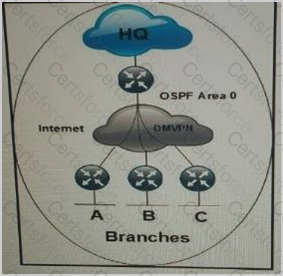You are working on a network design plan for a company with approximately 2000 sites. The sites will be connected using the public Internet. You plan to use private IP addressing in the network design, which will be routed without NAT through an encrypted WAN network. Some sites will be connected to the Internet with dynamic public IP addresses, and these addresses may change occasionally. Which VPN solution will support these design requirements?
A regional ISP is running MPLS TE. These tunnels are configured manually using paths. Which technology centralizes the traffic engineering decisions to reduce operational complexity?
Refer to the exhibit.

In a link failure scenario, what is a benefit of adding APS protected link to the design solution?
ACME Corporation is integrating IPv6 into their network, which relies heavily on multicast distribution of data. Which two IPv6 integration technologies support IPv6 multicast? (Choose two.)
As a part of a network design, you should tighten security to prevent man-in-the-middle. Which two security options ensure that authorized ARP responses take place according to know IP-to-MAC address mapping? (Choose two)
Which two foundational aspects of loT are still evolving and being worked on by the industry at large? (Choose two)
Which mechanism does OSPF use to prevent loops in an MPLS Layer 3 VPNS environment?
A switched network is being designed to support a manufacturing factory. Due to cost constraints, fiber-based connectivity is not an option. Which design allows for a stable network when there is a risk of interference from the manufacturing hardware in use on the factory floor?
You are redesigning a high-speed transit network due to congestion-related issues. Which congestion avoidance mechanism can you apply to the existing network?
Refer to the exhibit.

Each branch network must connect to the HQ and other branch networks over the phase 2 DMVPN network using a single tunnel interface. OSPF is running over the DMVPN network. Which network type is compatible with the DMVPN tunnel and ensures that the next hop of any route is unchanged?